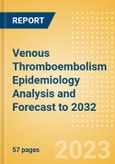The publishing epidemiologists forecast an increase in the diagnosed incident cases of VTE in the 7MM, from 1,469,547 cases in 2022 to 1,690,608 in 2032, at an annual growth rate (AGR) of 1.50%. The number of VTE attacks is forecast to grow from 1,602,747 in 2022, to 1,848,622 in 2032 in the 7MM, at an AGR of 1.53%. The publishing epidemiologists also forecast the number of medically ill patients at risk for VTE to increase in the 7MM from 38,508,614 in 2022 to 41,825,735 in 2032. In addition, The publishing epidemiologists forecast the number of total knee replacements will grow from 1,604,653 in 2022, to 1,834,770 in 2032 and the number of hip replacements will increase from 1,107,902 in 2022, to 1,240,077 in 2032, at an AGR of 1.43% and 1.19%, respectively. The publishing epidemiologists have identified the predominant drivers of this market to be changes in country-specific incidence and procedure rates, as well as in the underlying demographic trends.
Scope
This report provides an overview of the risk factors, comorbidities, and the global and historical trends for VTE in the seven major markets (7MM: US, France, Germany, Italy, Spain, UK, and Japan). It includes a 10-year epidemiological forecast for the diagnosed incident cases of PE, DVT, and VTE, as well as the number of VTE attacks, the number of medically ill discharges that are at risk for VTE, the number of primary total knee replacements and revisions, and the number of hip replacements, each of which are segmented by sex and age. Additionally, it includes a forecast for the number of recurrent VTE cases at one and 10 years after the incident event, a breakdown of proximal and distal DVT, unprovoked and provoked VTE, and the number of diagnosed VTE cases with cancer and chronic kidney disease (CKD) as comorbidity. Although not covered in this report, the attack number and rate for PE and DVT can be found in the model, in addition to the medically ill population at risk for VTE receiving any form of prophylaxis.Reasons to Buy
The venous thromboembolism epidemiology series will allow you to -- Develop business strategies by understanding the trends shaping and driving the global atrial fibrillation market.
- Quantify patient populations in the global atrial fibrillation market to improve product design, pricing, and launch plans.
- Organize sales and marketing efforts by identifying the age groups that present the best opportunities for atrial fibrillation therapeutics in each of the markets covered.








